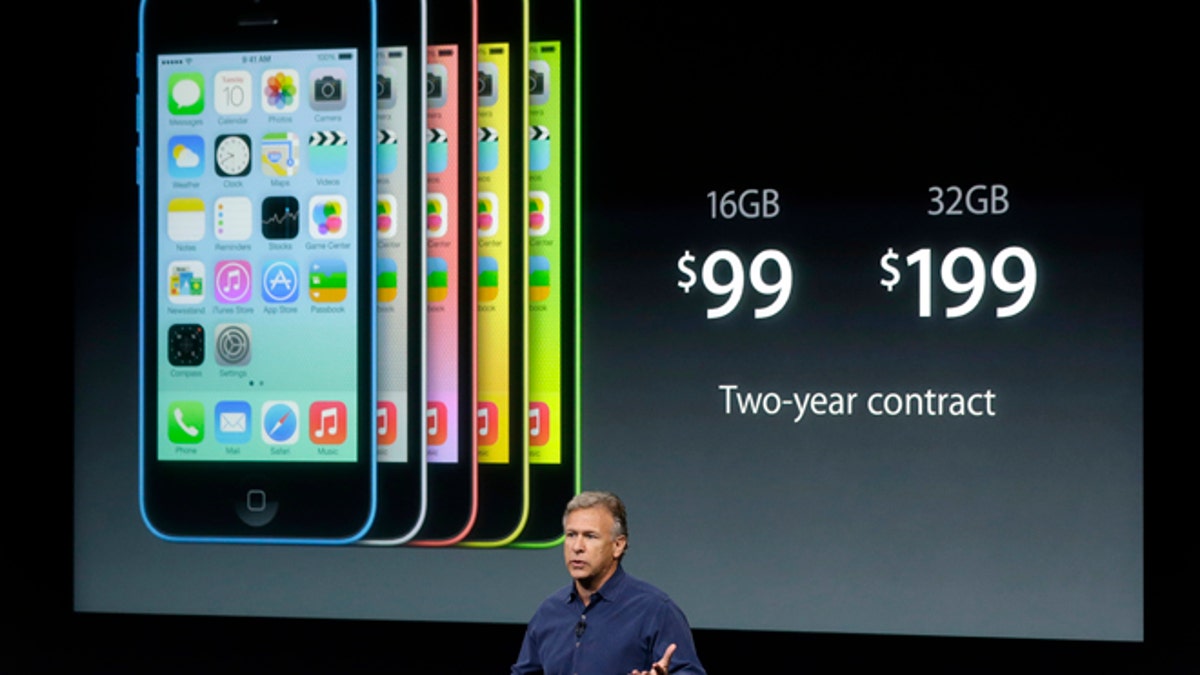
Phil Schiller, Apple's senior vice president of worldwide product marketing, during the introduction of the new iPhone 5c in Cupertino, Calif., Tuesday, Sept. 10, 2013. (THE ASSOCIATED PRESS2013)
Apple's new iPhone 5C was supposed to be the iPhone 5 Cheap, that is, a markedly less expensive alternative that would lead Apple's charge into promising markets like China and Latin America.
But on Tuesday, investors and consumers were introduced to a phone markedly the same. The iPhone 5C was launched at a starting price of $99, for a 16GB version with a two-year contract, and $549 without a contract. Comparably, the oldest iPhone on the market, the 4S, is being sold for $450 without a contract. Not exactly a revolutionary difference in price.
Analysts had expected a phone in the $400 to $500 range.
"Pricing for the 5C was a key disappointment and is likely to remain an overhang until details on post-paid pricing in emerging markets emerge in coming days and weeks," Bill Shope of Goldman Sachs said in an excerpt of his analyst's notes.
As Apple gets closer to completing a deal with China mobile's cellular network, opening the company up to its more than 700 million subscribers, on Wednesday the company's stock fell 4 percent due to investors' concerns about the higher than expected price of the iPhone 5C. According to the Wall Street Journal, the unsubsidized 16GB iPhone 5C is being offered for 4,488 yuan ($733) in China, which is significantly higher than the 3,000 yuan analysts predicted for the new more affordable iPhone.
The iPhone 5C is expected to be just as expensive, if not more, in Latin America due to import taxes. Brazil, which happens to be home to Latin America's fastest growing mobile and Internet market, is also home to the world's most expensive Apple products.
Brazilian consumers pay on average $1,138 per product, which is 28 percent more for Apple products than any other part of the world with an Apple Store. This goes in line with the fact that Apple makes the majority of its business out of the pockets of consumers in rich countries — it's part of their brand.
So, can the iPhone 5C make a dent into Samsung and Android's dominance in Latin America? The answer on its face is no, at least not anytime soon.
The International Data Corporation (IDC) projects Android will still own 68.3 percent of the world market in 2017, down from 75.3 percent in 2013. Meanwhile, the proportion of the world using Apple iOS will only go up from 16.9 percent in 2013 to 17.9 percent in 2017.
Latin America saw a 53 percent increase in smartphone sales in the first quarter of 2013 compared to 2012, according to the IDC. Only the Asia-Pacific region had a bigger increase in smartphone sales. The market is especially robust in Brazil, with an 89 percent increase, and Mexico, with a 61 percent increase.
Apple's challenge, then, is how to break into a market so strongly dominated by Android and Samsung. Android, on Samsung and Nokia devices, is the most prevalent mobile operating system in Latin America, according to StatsCounter, which covered the period of April to June 2013. For instance, in Brazil Android has 50 percent of the market, while Nokia and Apple's iOS have just 15 percent. In Chile, Android owns 63 percent of the market compared to Apple's 25 percent.
“Over the past 12 months, Apple has increased its share in the U.S. and UK, but globally there is an ongoing battle taking place between it and Samsung,” said StatCounter CEO Adodhan Cullen in a statement. “Should the rumors prove true, it will be fascinating to see if a less expensive iPhone will help it increase market share against lower cost competitors in global markets.”
Follow us on twitter.com/foxnewslatino
Like us at facebook.com/foxnewslatino
